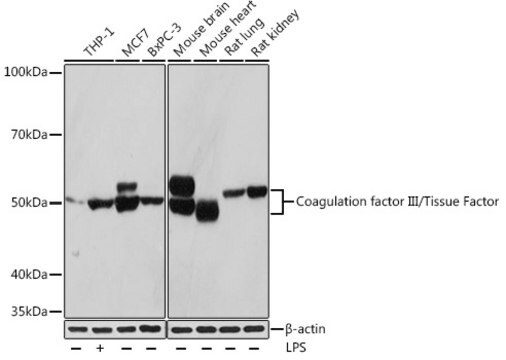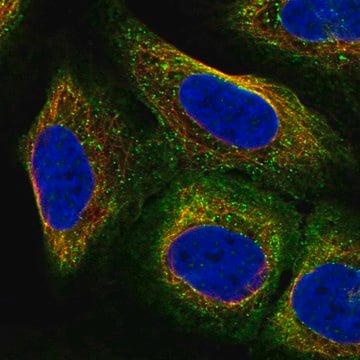MABF3203
Anti-Tissue Factor/CD142 Antibody, clone HTF-1

Synonim(y):
Coagulation factor III, HTF1-7B8, TF, Thromboplastin
About This Item
Polecane produkty
pochodzenie biologiczne
mouse
Poziom jakości
forma przeciwciała
purified antibody
rodzaj przeciwciała
primary antibodies
klon
HTF-1, monoclonal
masa cząsteczkowa
calculated mol wt 33 kDa
observed mol wt ~42-48 kDa
oczyszczone przez
using protein G
reaktywność gatunkowa
human, bovine
opakowanie
antibody small pack of 100
metody
ELISA: suitable
dot blot: suitable
flow cytometry: suitable
immunohistochemistry: suitable
inhibition assay: suitable
western blot: suitable
izotyp
IgG1κ
sekwencja epitopowa
Unknown
numer dostępu Protein ID
numer dostępu UniProt
temp. przechowywania
-10 to -25°C
informacje o genach
human ... F3(2152)
Specyficzność
Immunogen
Zastosowanie
Tissue factor: Identification and characterization of cell types in human placentae. (Faulk, W.P., C.A. Labarrere, and S.D. Carson. (1990). Blood 76:86-96).
Immunofluorescent studies of tissue factor on U87MG cells: Evidence for non-uniform distribution. Carson, S.D., and S.J. Pirruccello. (1993). Blood Coagulation and Fibrinolysis 4:911-920).
Flow Cytometry
Tissue factor antigen and activity are not expressed on the surface of intact cells isolated from an acute promyelocytic leukemia patient. (Carson, S.D., S.J. Pirruccello, and W.D. Haire. (1990). Thrombos. Res. 59:159-170).
Immunohistochemistry
Participation of cell-mediated immunity in the deposition of fibrin in glomerulonephritis. (Neale, T.J., P.G. Tipping, S.D. Carson, and S.R. Holdsworth. (1988). Lancet, No. 8606, 2:421-424).
Tissue factor antigen in senile plaques of Alzheimer′s disease. (McComb, R.D., K.A. Miller, and S.D. Carson. (1991). Am. J. Path. 139:491-494).
Immunoaffinity purification of the tissue factor protein
An inhibitory monoclonal antibody against human tissue factor. (Carson, S.D., S.E. Ross, R. Bach, and A. Guha. (1987). Blood 70:490-493).
Evaluated by Western Blotting in A-431cell lysate.
Western Blotting Analysis: A 1:500 dilution of this antibody detected Tissue Factor/CD142 in A-431 cell lysate.
Tested Applications
ELISA Analysis: A representative lot detected Tissue Factor/CD142 in ELISA applications (Carson, S.D., et al. (1987). Blood. 70(2):490-3).
Western Blotting Analysis: A representative lot detected Tissue Factor/CD142 in Western Blotting applications (Carson, S.D., et al. (1987). Blood. 70(2):490-3). .
Dot Blot: A representative lot detected Tissue Factor/CD142 in Dot Blot applications (Carson, S.D., et al. (1987). Blood. 70(2):490-3).
Inhibition Assay: A representative lot detected Tissue Factor/CD142 in Inhibition applications (Carson, S.D., et al. (1987). Blood. 70(2):490-3).
Note: Actual optimal working dilutions must be determined by end user as specimens, and experimental conditions may vary with the end user.
Opis wartości docelowych
Postać fizyczna
Rekonstytucja
Przechowywanie i stabilność
Inne uwagi
Oświadczenie o zrzeczeniu się odpowiedzialności
Not finding the right product?
Try our Narzędzie selektora produktów.
Kod klasy składowania
12 - Non Combustible Liquids
Klasa zagrożenia wodnego (WGK)
WGK 2
Temperatura zapłonu (°F)
Not applicable
Temperatura zapłonu (°C)
Not applicable
Certyfikaty analizy (CoA)
Poszukaj Certyfikaty analizy (CoA), wpisując numer partii/serii produktów. Numery serii i partii można znaleźć na etykiecie produktu po słowach „seria” lub „partia”.
Masz już ten produkt?
Dokumenty związane z niedawno zakupionymi produktami zostały zamieszczone w Bibliotece dokumentów.
Nasz zespół naukowców ma doświadczenie we wszystkich obszarach badań, w tym w naukach przyrodniczych, materiałoznawstwie, syntezie chemicznej, chromatografii, analityce i wielu innych dziedzinach.
Skontaktuj się z zespołem ds. pomocy technicznej







